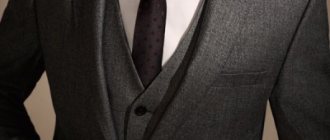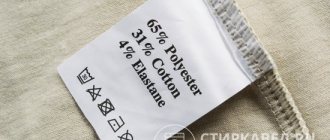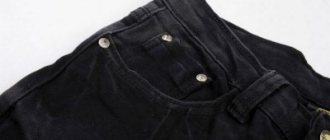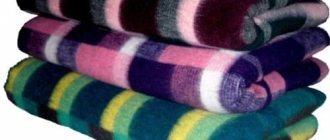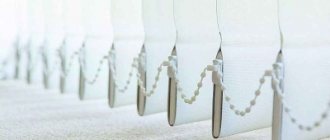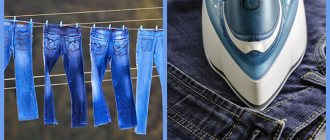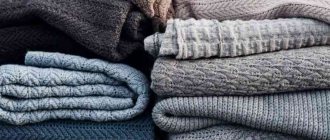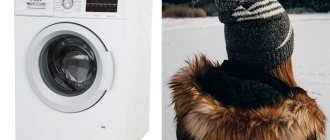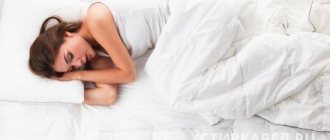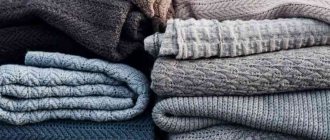Previously, in severe frosts, only fur coats or clothes made of natural down saved people. These clothes kept us warm, but were quite heavy and inconvenient to use.
Technology does not stand still, and now there is a semi-synthetic analogue of natural fluff - bio fluff.
We'll tell you what kind of material this is, whether and how to wash a down jacket with biodown in an automatic washing machine.
Is it possible to wash a bio-down jacket?
Such down jackets and down jackets are easier to care for than products made from natural down.
However, they may become deformed after washing, and one edge of the garment may become longer than the other. The down may become matted, the jacket itself may become wrinkled , and the product will lose its external luster.
Despite this, you can wash products made from bio-down, you just need to follow certain rules.
Properties and features of bio-down filler
The first production of the material was launched in the 70s of the twentieth century. Among the qualities of bio-fluff it is necessary to highlight:
- Hypoallergenic. Like holofiber, the material does not cause irritation or itching. Resistant to high humidity.
- No tendency to caking or deformation. The fibers retain their shape for many years. Prolonged strong compression can lead to the formation of lumps.
- A light weight. Outerwear with filling does not cause a feeling of fatigue and does not hinder movement.
- Compactness. Clothes and sports equipment with bio-down are not difficult to pack and transport.
- High level of heat retention. The insulation does not allow cold from the environment to pass through. The clothes are comfortable at -40 degrees.
To maintain the positive qualities of the filler, it is important to properly care for it. Following the rules will extend the life of your clothing.
Handwash
Washing a down jacket by hand is more labor-intensive than washing it in a machine. But they resort to it because they consider it more careful.
On the eve of washing, you need to check all pockets for foreign objects and unfasten all fur parts.
It is most convenient to wash the item in a large basin or directly in the bathtub. Washing water should be warm, but not hot . The maximum permissible temperature is 45 degrees.
Before washing, straighten the down jacket and “beat” it well so that the down:
- evenly distributed
- became more voluminous
- absorbed water evenly.
The detergent is dissolved evenly in the water, then the item is lowered and gently wetted.
You can use any powder for washing, but liquid detergent is considered more gentle , and dry powder is better at removing heavy stains.
You can replace the powder with soap, preferably baby soap. The soap is dissolved evenly in the solution, rather than lathering the entire jacket.
Exceptions are places with heavy pollution. For better washing results, the item can be pre-soaked, but not for more than a few hours. Prolonged soaking greatly compresses the fluff and spoils the item.
It is not forbidden to use conditioner , but with careful hand washing it is not necessary. Moreover, it is more difficult to rinse it manually.
During the washing process, you need to gently beat the entire down jacket with small amplitude movements. After processing the entire product, you need to wait until the water drains by itself and collect water for rinsing. Carry out rinsing with the same movements, repeat if necessary.
A big mistake when washing would be sudden and monotonous movements, for example, lifting the entire down jacket and suddenly lowering it into the water - this contributes to the filling falling off.
Also, you should not squeeze, especially twist, the product .
This will disrupt both the structure of the fabric and the structure of the filler. You need to wait for the water to drain on its own.
Scope of application: what to sew
The qualitative characteristics of artificial down material allow it to be used for stuffing and insulation:
- outer demi-season, winter clothing for adults, children;
- things, hats for tourism, hunting, fishing, sports;
- clothing for special purposes (suits for firefighters, submariners, etc.);
- shoes;
- upholstered furniture, individual elements of its decor;
- items, accessories for sleeping, relaxation (mattresses, sleeping bags, blankets, pillows);
- elements, home decoration items;
- soft toys, children's goods;
- things of your own, homemade handicrafts.
Winter clothes
Winter outerwear and hats insulated with artificial down are the best choice for the capricious, wet, frosty winter season.
Due to the presence of air in the cavities between the fibers of the main threads of the material, even a thin layer of such filler in a down jacket provides:
- good thermal protection at very low air temperatures (up to -35°C);
- protection from moisture and precipitation;
- freedom of movement, comfortable wearing.
Manufacturers of warm clothing use synthetic down not only to fill the internal space of products, but also for their external, decorative edging. Eskar will tell you about Roman roller blinds in this material.
How to machine wash?
For washing in a washing machine, you should also use non-hot water - 40-45 degrees.
The best programs for washing outerwear are:
- delicate wash,
- "No folds" mode
- Some models have a special mode for down products - “Down Jacket” or “Down Blanket”.
It is also important to choose the right spin, or abandon it altogether. Spin should be no more than 600 rpm.
When choosing a detergent, you need to keep in mind:
Dry powder washes better, but rinses worse. In some modern machines with a water saving mode, such powder may leave streaks.- Liquid powder, especially for delicate items, washes worse, but will treat the item more carefully.
- Fabric softener is not prohibited, but you will have to use an additional rinse.
For better distribution and then rinsing of the powder, as well as maintaining the shape of the product, it is recommended to place several balls in the washing machine along with a jacket or down jacket. Tennis balls are great .
If there are heavily soiled areas on a down jacket or down jacket, it is recommended to pre-soak them for a couple of hours, or better yet, simply moisten them with water and wash the soiled areas with washing soap.
It is recommended to wash the down jacket with all zippers and buttons fastened, from the wrong side.
This video will show you how to properly wash down jackets in a washing machine:
Varieties
The modern artificial insulation market offers a wide range of padded synthetic down. The classes and types of such materials differ from each other:
- Production method.
- The structure of the main fiber.
- Wear resistance coefficient.
- Some quality characteristics.
Thinsulate
Thinsulate is the lightest, thinnest, most elastic type of artificial down. It was originally developed to insulate the clothing of astronauts and polar explorers. To obtain insulation, they use the finest, with a high content of silicone impregnation, twisted, intertwined at different angles, spiral-shaped polyester fibers. Read about the description of corduroy furniture fabric here.
Special characteristics of the filler:
- does not shrink, does not deform;
- There are 15 modifications, subclasses;
- fire resistant;
- does not absorb moisture at all and does not get wet.
Thinsulate thread thickness is 70 times thinner than human hair, the material is 2 times warmer than natural fluff.
This type of filler is indispensable when sewing:
- special tourist and military uniforms;
- fishing, hunting, ski suits;
- shoes
Comforel
Artificial filler Comforel is a non-woven material made from hollow polyester fiber using special heat treatment and water-repellent impregnation. Its characteristics and properties:
- fluffy fiber has a structure in the form of twisted, interlocking small balls (Ø 5 mm);
- antibacterial impregnation that prevents the appearance of dust mites, mold, and mildew in the fiber;
- hypoallergenic;
- not electrified.
It is able to hold products well and restore shape after compression and washing.
Holofiber
Holofiber and thermofiber are fibrous insulation made from silicone-coated polyester or polyester. Its structure consists of hollow, intertwined spiral fibers, with air layers (cavities) between them. Read about Ivanovo knitwear Russia at this link.
Depending on the operational characteristics and its purpose, Holofiber comes in the following types:
- Volumetric is a voluminous fiber for giving shape.
- Puffs – filler in the form of balls.
- Soft, tech - with a special coating on the upper/lower parts that keeps fibers from migrating in the fabric.
- The medium is especially gentle and soft.
- Hard – thick, dense, retains its shape well.
Synthetic
Synthetic down is insulation made from polyester threads impregnated with silicone. How to choose a mattress protector for a mattress, read this article.
The fiber was developed taking into account the characteristics of the human skin structure, provides high thermal insulation, is safe, completely environmentally friendly, and does not cause allergies.
Unlike fibertek insulation, synthetic down has a number of disadvantages:
- poor air circulation in the fibrous structure;
- holds its shape worse under load.
Under the influence of washing and sweat, after 3-4 years it begins to lose the quality of thermal insulation;
How to dry it properly?
The final result of washing the product greatly depends on proper drying.
Under no circumstances should things with bio-fluff (for example, you cannot simply hang a jacket folded in half on a rope). Eliminating such a gap will not be easy.
For best results, allow most of the water to drain. To do this, you can simply leave the item lying in the bath.
Or immediately lay it out (not hang it up, but spread it over the entire surface of the dryer) to dry, and lay rags down, which you can wring out as they get wet.
If most of the water has drained from the down jacket and it is slightly damp, you can hang it on a hanger vertically .
You can’t put such things on the battery, but you can put a radiator nearby (at least 40 cm from the thing) to speed up the process. Biofluff does not ignite, but melts.
You shouldn’t relax during the drying process either; you should regularly turn the jacket over and fluff up the fluff. True, such things usually do not dry for long - 3-4 hours .
Such things can also be dried in special drying machines. Some have a special mode for down jackets.
If there is no such mode, then the minimum drying temperature is selected (no more than 30 degrees) . It is better to carry out several drying cycles at a low temperature than to set it to high and ruin the item.
Summary
In conclusion we can say that:
items made from bio-down can be washed at a temperature not exceeding 40 degrees;- When washing by hand, you need to constantly beat the fluff, and when washing by machine, add tennis balls;
- the product cannot be wrung out, twisted, or folded in half;
- wash and dry the down jacket buttoned up and inside out;
- until most of the water has drained, the item should be in a horizontal position;
- you need to unfasten all the fur parts, and if they do not come off, take the bio-down product to the dry cleaner.
General recommendations
The optimal temperature for washing the product is 30-40 °C. If you set the temperature lower, you won’t be able to get rid of dirt, and if you set it higher, the filler will roll off.
A suitable product is gel powder, since standard dry powder leads to white spots and unsightly streaks. Special detergents for washing down and wool products are suitable, since they do not contain sodium perborate, which provides a more acidic environment, since an alkaline environment risks destroying bio-down fibers.
Bleach and conditioner should not be used.
Be sure to read the information on the product label. The manufacturer indicates the maximum water temperature for washing, the ability to machine wash the product and use an iron. So, if the label shows an image of a basin with a palm, then such a product can only be washed by hand, but if the basin is crossed out, then you will have to be content with dry cleaning or dry cleaning.
